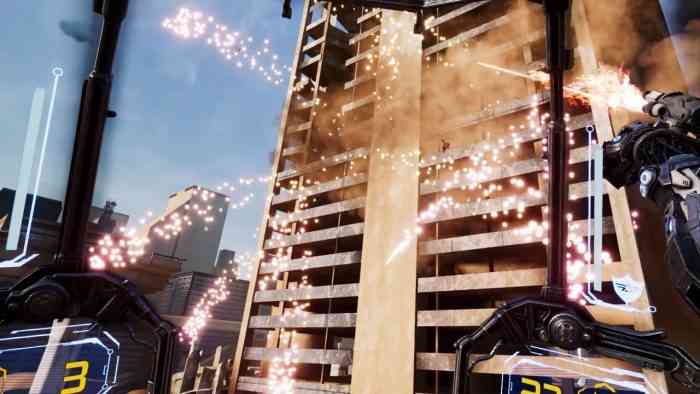Archangel: Hellfire Review
It’s almost inaccurate to label Archangel: Hellfire as an expansion to Archangel, Skydance Interactive’s 2017 mech shooter, because there’s so much new content here that it feels more like a full sequel. Not only does Hellfire bring mech classes and online multiplayer (both PvE and PvP) into the mix, it also addresses the original’s much-criticized on-rail movement by introducing free locomotion. However, more content may not be enough in this case. Archangel: Hellfire’s streamlined approach to mech combat lacks the level of complexity required to sustain long-term online play, making it a fun but ultimately forgettable experience.
The addition of three mech classes is the other big change in Hellfire. The Light, Medium, and Heavy mechs each have its own strengths and weaknesses. The Light mech zooms around the battlefield at high-speed at the cost of armor, making it great for flanking. On the other end of the spectrum is the Heavy, which has high armor but low mobility. The Medium mech is, as you can imagine, a compromise of the other two.
The different classes also come with unique weapon loadouts. The Light mech has handy homing missiles, the Medium has a powerful railgun, and the Heavy has a shotgun that devastates at close-range. Disappointingly, you cannot customize these loadouts. While this helps simplify gameplay and maintain balance, it feels arbitrary for those homing missiles to be locked to the right hand, with no option to swap them to the left. For a game about giant robots, I also expected a larger arsenal of sci-fi weaponry, but there are no further weapons to unlock – what you see is what you get.
Mechs Made Simple
What is customizable is the power allocation of your mech. By reaching up and moving around four sliders, you can choose which attributes to strengthen: armor, damage, speed, or energy generation. This is very easy to do, and for a quicker solution, you can always press one of the buttons next to the sliders to use a preset configuration. However, the effects of changing your power allocation are not always obvious. There are no raw stats or damage numbers displayed in the cockpit, making this whole process a bit of a guessing game. I could never actually tell how much difference it made when I pumped all my power into one attribute, so most the time, I never bothered changing the default configuration.
Once your energy meter reaches certain thresholds, you can also activate one of two class-specific special abilities, such as a missile barrage, EMP blast, or temporary invulnerability. The problem is that these abilities never see much use in combat. Since energy is also used for basic abilities like shielding or hovering, you’ll rarely get an opportunity to pull them. The second you fire that EMP, you become an easy target, making it unwise to use these special abilities even if you have the energy to do so. This leads us to the issue of complexity.

After some time online, it’s hard to avoid feeling that Archangel: Hellfire’s gameplay is too simple. There’s little room for strategy or creativity when it comes to combat. It doesn’t help that the special abilities and the power allocation mechanic are almost inconsequential. As a result, matches play out very similarly to one another. This is especially noticeable in PvP (either 1v1 or 2v2 deathmatch), which sees players mindlessly gunning at each other in wide open areas until one side runs out of lives.
That’s not to say you should write Archangel: Hellfire off completely; dodging incoming rockets and destroying environmental landmarks will always have its charms. The PvE mode also does a good job at staving off the monotony. Here four players work together to fend off increasingly difficult waves of AI tanks, planes, and superstructures. Health is a scarce resource, so it becomes quite intense towards the later waves, particularly when all your teammates are on the verge of death.
Lifelike Locomotion
On top of that, Hellfire is an incredibly polished VR experience. As mentioned, all mechs are now controlled with free locomotion. The left stick is responsible for movement, while the right is used for snap turning. Aiming and shooting is a breeze as your mech’s arms follow the position of your own. The lumbering motion of the mech, combined with an interactive cockpit, go a long way in selling the feeling of being inside a massive robot.
Archangel: Hellfire may be exactly up your alley if you’re looking for a pick-up-and-play VR shooter. With the PvP mode now free for all Vive and Oculus Rift users, there’s really no reason to not try it out for yourself. Owners of Archangel receive access to the PvE co-operative mode along with some bonus skins. But for players like me who seek more depth in multiplayer shooters, you may not find much lasting appeal in Hellfire.
*** A PC code was provided by the publisher ***
The Good
- Lots of new content
- Free locomotion, finally
- Intense PvE mode
The Bad
- No weapon loadout customization
- Combat systems lack nuance

